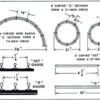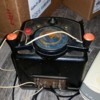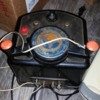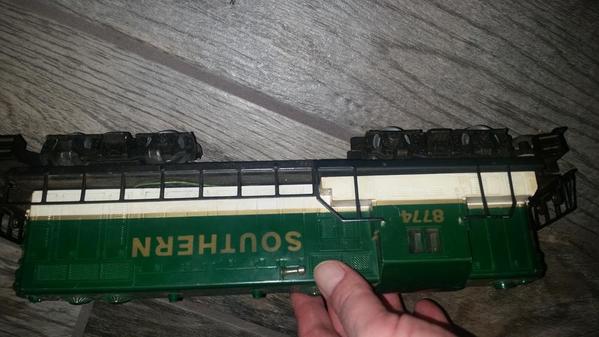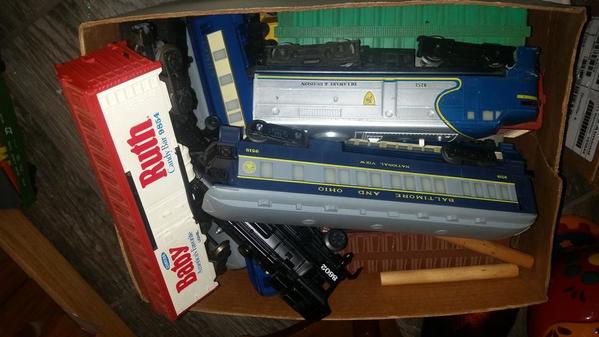So I have my grandfather's 45 year old train set down. I have a big figure 8 set up around telling xmas tree and "present mountain." I am using some straight pieces so it isn't a curved 8 like normal sets to get around the tree. Track doesn't line up. I noticed in sets they have half track pieces. I have tons of spare track and can cut some but I need to know the length of their half pieces and possibly how many. The cross part isn't as long as the normal track. It's maybe 12 ft by 8 ft anD I can double that size, so it may get set up in terms sunroof year round and pull out my old smaller scale set for xmas. So diagrams and track sizes may help. All track and trait's are older than I am. I have one engine that is 45 years old. Alco model 8252 from 1972. Lol. My grandpa loved his trains, so did I, I used them a lot. Thanks in advance. And yes I'm a noob here. I haven't used the set since I was 10 maybe. Power box is getting rebuilt today.
Replies sorted oldest to newest
I think I may have figured it out. 4 7/8" it looks like. The gap in my track is 5 1/8 or so. That doesn't include room for the pins etc. I'm either going to cut a section or buy one when I pick up my transformer box from being rebuilt tomorrow. I got a used box of track today that would probably do a 10 to 15 foot loop for $20. Of course I think he gave me a good price since my grandfather bought traims from him and some if them he bought back when he got sick. Thanks.
it's hard to tell which track that you have when you say O27.
If you measure the curve on the center from end to end, is it around 9.5" long or about 11" long?
Another way to tell is to lay a piece of track on the table and place something flat across the rails - then measure the height from the table to rail head.
Check against the chart. (attached) The smaller curve and lower rail height is O27 track.
You are doing what you can by cutting a piece to make it work. We can also figure it out with software.
Attachments
That's about what we had. We had the transformer rebuilt from the 1960s and no power went to the track after that, like terrorist connecter went bad yet had worked. We figured a short in the track but not anymore. The train didn't even make it a lap and stopped and you get sparks at the track connector. This is my grandfather's train set and most is older than I am so I don't want to mess it up and use it right.
That's about what we had. We had the transformer rebuilt from the 1960s and no power went to the track after that, like terrorist connecter went bad yet had worked. We figured a short in the track but not anymore. The train didn't even make it a lap and stopped and you get sparks at the track connector. This is my grandfather's train set and most is older than I am so I don't want to mess it up and use it right.
If it helps anyone the track is used but everything else it 45ish years old. If it worked before the transformer was messed with I can only assume it's something there.
There's a few things that can make that sparking happen.
- More track lock-ons for better power distribution
- heavier wire to the lock-ons
- Clean the wheels on the engine - alcohol , Q-tips, lots of rubbing
What's the transformer model number? The U terminal is for the outside rails and a voltage number or A for the center rail.
It's a 190 watt and very old. It can run 2 trains, has the 6w, 20w and the U peg. The power cable was frayed so we had it checked out. We also took the trains in for oil etc before running them. I for one thought cables since they were also 40 years old. Haha
I was speaking of the wires from the transformer to the track. Speaker wire is not enough. 16awg or 14awg. U & 20 to the track. U is outside rail.
Look at page 42 of this for how to use multiple lock-ons to cure voltage drop. handy dandy guide. Save it on your device for future reference.
Attachments
It would be helpful if you could post a picture of the track and power supply. Do you have access to a volt meter to test the output of the transformer?
I know I can get the model number on it ad I looked it up myself. We did maybe double the size of the track or more, so when larger one power connector won't due. The track was longer than my grandfather's old setup even. The wireason we are using wad used when I was young, so I feEl that's an issue too as I had to reconnext the cable at first fir power, like corrosion was in the way at first. I didn't put a voltmeter to it just a bulb that lights up steady. The transformer was rebuilt and checked out by a pro that day as the power cable was replaced. The shop that sold it to my grandpa did the work and mentioned how good the power supply was.
It's a trainmaster type kw 115 volts 60 cycle 190 watts transformer it's old old
Attachments
It's a trainmaster type kw 115 volts 60 cycle 190 watts transformer it's old old
We were running maybe 20 feet of track or more. Our 7477 diesel from 1977 made a half a lap.
Preferredduck posted:We were running maybe 20 feet of track or more. Our 7477 diesel from 1977 made a half a lap.
Couldn't find that engine. Do you recall grandpa running it?
Lionel made some DC engines in that time frame.
First off, and.not a problem, but I noticed the position of the handles. Is one at full power and.the other off? Normal KW handles both swing clockwise to on. A very very rare version, they work towards you off, away for on, in opposite directions. If thats the case it should be documented asap as.it is unconfirmed history.
You may need.to clean the track pins and holes on old track.
Look at Menards home improvement online. They have new full O track at reasonable price. Adaptor pins will mate it to 0-27, though there is a slight difference in height.
The simplest way to begin would be the meter. If its an ohm meter too, switch to ohm and.check for a short between center & outer rails. (Diode works too, many will beep on a connection in diode setting). Do this with the lock-on off the track. Press around on the center rail where the train stopped. The insulating cardboard may be bad. Find a shorted one? I bend tabs up and slide a piece of shoe box or similar in there.
You also have extra track. So put the lock on a piece or 2 of extra and see if the issue moves. If it does, remove the lockon and insert a wire into the track pin holes and test again. You now know either the lockon is bad, or the KW has a new issue.
Process of elimination by pulling and replacing a few peieces at a time will find the track short if its intermediate (off and on issue occuring randomly)
That KW is a good transformer, lots of amps. Too fat a wire is better than too small a wire. An old extension or power cord will work if you are on an extreme budget, but thats rather large and may need a few strands removed from thd end to fit a lockon. You can also solder wire right to the track since you have extra. A soldered connection leaves little doubt its a good connection.(use the outside of the outer rail, or bottom. Center rail doesnt matter).
I got unexpected company..Ill be back..
Fyi The 6w & 20w posts are the constant voltage (v) 6v & 20v, not watts. Watts is a voltage/amperage combo formula you will seldom see referd to in trains outside of transformers.
And these posts are long because you seem quite new and Im trying to cover the bases widely.....or becuase I always post long ![]()
Comments on my comments, to clear that up more.
Lightly crimping the adjoining rail over pin notches will improve connections. But clean connections are important. If the track is rusty try removing pins and dunking in "Evaporust" (common) rinsing and drying well...just remember, new track works like a million bucks.
Look at your track pins too. Some O27 got hollow pins rolled from sheet metal. They tend to rot inside out, and can get red hot with just the current of the loco drawing across them. I suggest buying solid pins for the center rails. Outer rails too eventually, but they have twice the metal so carry less current per pin and arent as risky there. Feeling CAREFULLY for heat is another test for shorts and resistance too.
Like Moonman said; more power feeds. 20ft of track needs more connections than one, especially old track. You need to run whats called a "bus" circuit. A fat wire to feed lots of power a long way, and smaller "drops" at each connection point. Id run at least four drops on an oval that long, more likely 6-8 & right at the curves is best, one for each leg of a turnout or X track crossings are a good idea too.
I cant find an engine reference in Greenburgs or online for 7477. Its not an 8377 is it? Military? That is dc only, so it likely has a toasted motor now. A dc motor can run a few seconds on ac, but will burn up. Ac motors can run on dc volts mostly, there are some exceptions, but no damage occurs.
It is cheap to replace those dc motors, but it will need a bridge rectifier(-$10) added inside to use ac and thats one direction only, or a switch to reverse, or an electronic e-unit (reversing, board) which might have a bridge rectifier built into it; check. (Always save an old motor for the gear, just in case. Get a box for "stuff" going. Tackle box?)
Even if that is the wrong engine # Im guessing with, see if you can tell, does the motor look like a toys motor ?(can motor, still good, they got better too) or does it look like a small fan motor?(Pulmor ac/dc open frame type).
If its a can motor from that era, its likely dc only, likely cooked. You would need to check for an electronics board possibly too. If you have hands on abilitly, the knowledge you need is here for the asking. As simply put as you need it, or as in depth as you want it.
A pulmor can be serviced. At home, with folks here guiding, by reading old threads, watching on youtube, etc.,or by a pro if you like. Its not hard
The id has got me going.....Somewhere on most engines is a "roadname" and a number, list that here. If your giving us a set number, thats of no fast help, but another ID oriented site might like box or train photos if its rare.
Note how many wheel sets are on each truck. 4, 6, or a combo?
And look at these body styles too- Carbody/ A unit (chuggington) , gas/diesel/electdic switchers("critters" by size) are small and squared gas/diesel, NWs or SWs are the bigger common "switcher", RS is an industrial road switcher(does both, med-long, rounded edges design) , and a GP is a med. industrial hauler, a U boat - (longer?) industrial, FM Train Master heavy industrial, very long and doesn't like 027.
Carbody A units(with cab) are E (3 axle per) & F (2axle per) , the B has no cab, adds power. An Alco A unit has a similar look, less curve on the nose top, 2 axle per. truck, there a Bs for those too. An Alco is not a carbody its built on a frame. A carbody's frame is integrated with the body. I.e. The body is the frame. Lionel Es and Fs are usually jewels, the Alco tend to be more toyish.
I may have the model wrong. It's a green diesel made 76 and 77 for sure, no sound board. I know one is an 8262 built in 72, deleware something or other. It's blue and silver. Its one of the earlist ones I remember playing with. It was 8774 on the side. Lol. We had it checked at memory station before we ran it.
It worked at first then when expanded stopped. I did change out the track where it stopped. Also it's off and unplugged, when it didn't run last time the power strip was turned off so the handle was working as it should. We used them both when younger. It wasn't hooked up in that photo, it was Un hooked and out if the way. The clamps that connected to the track got hot. I though corrosion for the fact that when it ran at first u had to unscrew the connector and tighten it back down and it ran like it wasn't connected good. We anti corroded the cables but haven't hooked it up yet. I was thinking of making some with 14ga wire and connectors I used for engine grounding kits. It's strange how it worked for just a track short esp as we hooked up the new pieces only as a last ditch effort in an oval like we had before. Seriously thanks for the info. I'm hoping my daughters kids will be able to play with the train too.
Attachments
I posted the pics, it was easier. I didn't know that about the bus but it makes sense. With the age if everything and it's sentimental value I will learn all I can about them so no problems with long replies, I don't mind. I'm in the 10% of Americans thay read an article to the bottom. Like I had mentioned the clips got hot thay connected to the track so it seemed the track just didn't get the heat esp since we used the same track and connector thay had worked for us already. So a good bet is get solid pins and just re-pin it to make it safer, I remember the sparks on the wheels back the the day. Speaking of sparks I noticed that at the track connector for the power cable. And again thanks a bunch. I've been reading all I can. Some guys have dream setups for me on here. Lol
Let's put the DC motor theory to rest, now that we have a photo of the engines. They are MPC from the mid to late 70's and run on AC, which is what the KW puts out. For the record, the value of those trains is primarily sentimental. The monetary value isn't that much, and the pieces are fairly easily replaced. As was mentioned earlier, they are also easily repaired.
Do you have a Volt - Ohm meter? If you don't you can get one for less than $10. Very handy tool, especially if you want to play with trains.
There may be a short in a single piece of track. This can happen if one of the fiber insulators on the center rail is damaged. It only takes one, and it may not be obvious from visual inspection.
First, disconnect the track from the transformer. Then, using the meter on the Ohms (Ω) setting, touch the center and one outside rail with the probes. If the reading is zero, you have a bad piece of track. To locate the bad piece, open up the layout in two places, cutting it in half. Test each half. Repeat this process until you find the bad piece. Just remember that there may be more than one bad piece. This "binary search" method is still faster than checking every single piece.
Sparking wheels and rollers are usually a sign of dirty track or the rollers themselves.
I was thinking the same as Elliot. Ducky, if you look at a piece of track closely, you will see what looks like a piece of cardboard under the center rail to prevent it from touching the metal tie. The outside rails do not have those insulators.
One of the pieces of track that was added in when you expanded the layout more than likely has a center rail touching and shorting the power. That will cause the clips to get hot.
Do as Elliot says to find the bad track or tracks. Then, you will be having fun again.
Thanks for photos of the trains. They look to be in good condition.
He sold the valuable ones when he got cancer because there was much more. I do have a meter as I figured checking each track piece was coming too.
We had rules with them when younger and we took it very seriously. The 8252 front end got cracked some years ago, other than that most of it is in good shape. My grandmother smoked so we are currently removing nicotine from some. Others were stored and like new still. I was thinking in these directions but learning some first is good before tearing things up. My nephew loved the train around "present mountain."
* https://en.wikipedia.org/wiki/Whyte_notation
Your story is reflective of my own. Following rules and responsible actions were rewarded with a new level of trust concerning rarer and more powerful units....and that jumble of cars in the box is reminiscent of my own for years, but non the less, killing me today, lol. Boxes within boxes saves tons of damage ![]()
Those are traditional Pulmor motors. Folks will know them quickly if refered to as: Southern GP-9 #8774, #8602 * 2-4-2 Columbia style steamer, D&H Alco #8252 (I always thought a sharp engine) etc. etc.
The cars also have a similar number on most too. In fact the cars often have the build date on the side. "BLT by Lnl 77" etc. The B&O passenger cars are "Baby Madison's" ("027" version not full sized)
The info is a little scattered. I assume no other train is running past that point right? You should test with another unit before doing all this track work.
The solid pin is safer IMO yes. I burnt myself on one of the hollow ones, then about a year later, running baby Madison's in the dark, I noticed another because it was glowing red hot. If you can, replace all 3 pins. But the center pin does more work, so solid metal pins should be done there 1st.
If its on carpet, red hot can cause a fire. Plus if you have a little one, that heat and/or 10vac± on soft young skin are going to be felt when encountered.
Lean a sweaty forearm across a powered track and you'll get an unpleasant little bite, kinda like testing a 9v battery on your tounge.
Your guesses about corrosion and resistance and heat are correctly related, but heat isn't always there. Cleaning the contact points of a piece of track and the lock-on blades would help. Wire brush, fine sandpaper, etc. any coarse rust. Oil &wipe to loosen fine rust, etc. Check for debris on the underside, etc.. Power can jump via rust streaking on one the lock on. There are actually quite a few variations of lock ons too.
(Watch stray abrasive, never steel wool where the train runs because the stray particles are magnetically attracted to the trains when running)
I still have to boxes for 2 of the sets with the foam in it, the box is temp storage while ppl were over since it wasn't running at the time anyways. It is on tilet with no carpet around. I prefer a more permanent solution where others don't want to clean around it all year. Lol. Space is another one and the little one is just turning 4. I have my small HO set frpm 1988 in the attic, flex track, cars, and the nice red and silver Sante fe engine. Lol. That we can put on a board and flip up for storage easier than the 027 stuff. The guy who sold my grandpa his stuff has serviced all the engines and we bought used track from him too. He had 2 green engines thay came in a set thay goes for about 200 now and a steam engine that is about 2 bills now too. He had a blue Sante fe switcher with yellow writing and I swear he had a silver passenger train made of metal, I remember running my nail through the grooves on top and a silver engine, diesel if I recall. He had so much it wasn't even funny. He converted a pool table into a setup with a tressel and hill, of course the hill wad on a corner and if I remember correctly by brother crashed the alco 8252 off that curve. Haha. All the passenger cars still light up etc and we bought a newer steamer since we werent sure ours were good, sound card is gone but everything else is fine on the thankfully. I tell you I like pics of other train set ups. I've always wanted a train room or even an around the room train on a ledge.
Also quick question. I was thinking of being able to quickly save space and put up the track. 0-27 is a 27" urge radius correct. So 2 32ish inch boards in width to make an L might work to have a good straight and corner and not be an oval. Basically have all pieces secured to wood except 2 that will go down when the train is set up could possibly work as a space saver when not running but get decent track. I read keep track 30" for reach basically. Right now I'm reading one basement set up I will dream about on here. Through walls and around a massive basement, turn around etc.
I worked for a mack truck dealer and he gave me some scale mack trucks, I wonder if I can get him to do a display at his shop with his trucks. Hmmm. He has major dough hahaha.
I do have a sunroom filled with cactus in the winter so I've thought some may get incorporated i can. With kids and grandkids the spare room doesn't have space for it. In 8 years I can have a 900 Sq ft train room. Until them it's a small board to tuck away or a way to do a simple set up with layers maybe. Who knows.
Preferredduck posted:Also quick question. I was thinking of being able to quickly save space and put up the track. 0-27 is a 27" urge radius correct. So 2 32ish inch boards in width to make an L might work to have a good straight and corner and not be an oval. Basically have all pieces secured to wood except 2 that will go down when the train is set up could possibly work as a space saver when not running but get decent track. I read keep track 30" for reach basically. Right now I'm reading one basement set up I will dream about on here. Through walls and around a massive basement, turn around etc.
Yes, that would work. Also, some use the hollow interior doors for a layout that can be carried and stored. (borrowed from HO) They are 32" w or 36"w by 72" L. A 32" curve would be 4 curve pieces and 1 half -straight. A 36" would be 4 curves and one full straight in between, when using O27 track and small curves.
The door can set on the floor, on a table, on saw horses. You get the idea.




